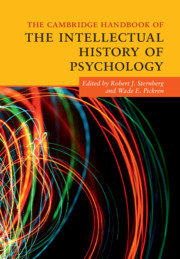Book contents
- The Cambridge Handbook of the Intellectual History of Psychology
- The Cambridge Handbook of the Intellectual History of Psychology
- Copyright page
- Contents
- Figures
- Tables
- Contributors
- Introduction
- 1 Major Paradigms and Approaches in Psychology
- 2 Methodology in Psychology
- 3 Neuroscience in Psychology
- 4 Sensation and Perception
- 5 Attention: Awareness and Control
- 6 Learning
- 7 Memory
- 8 Decision-Making
- 9 Creativity
- 10 Intelligence
- 11 Development
- 12 Social Psychology
- 13 Gender
- 14 Emotion
- 15 Motivation
- 16 Personality
- 17 Abnormal Psychology
- 18 Psychotherapy
- 19 Health Psychology
- Index
- References
8 - Decision-Making
Published online by Cambridge University Press: 18 May 2019
- The Cambridge Handbook of the Intellectual History of Psychology
- The Cambridge Handbook of the Intellectual History of Psychology
- Copyright page
- Contents
- Figures
- Tables
- Contributors
- Introduction
- 1 Major Paradigms and Approaches in Psychology
- 2 Methodology in Psychology
- 3 Neuroscience in Psychology
- 4 Sensation and Perception
- 5 Attention: Awareness and Control
- 6 Learning
- 7 Memory
- 8 Decision-Making
- 9 Creativity
- 10 Intelligence
- 11 Development
- 12 Social Psychology
- 13 Gender
- 14 Emotion
- 15 Motivation
- 16 Personality
- 17 Abnormal Psychology
- 18 Psychotherapy
- 19 Health Psychology
- Index
- References
Summary
The history of the psychological study of decision-making has its roots in modern theory of probability in the seventeenth century. Here, we describe the historical evolution of ideas from a conception of decision-making as rational to one that is biased and emotional. The historical periods can be divided into two parts, roughly before and after the 1950s. Before the 1950s, decision-making in the mind was thought to reflect pure mathematics. After the 1950s, the weaknesses and inconsistencies of human decision-making became more and more obvious. Ultimately, the elegance of pure mathematics was rejected in favor of theories that captured the messy irrationality of the human mind. The most recent theory shows how biases and emotionality can be part and parcel of advanced decision processes that involve intuitive gist. Thus, modern theory has begun to move beyond Cartesian dualism to encompass cognition, emotion, personality, and social values to predict decision-making.
Keywords
- Type
- Chapter
- Information
- The Cambridge Handbook of the Intellectual History of Psychology , pp. 216 - 249Publisher: Cambridge University PressPrint publication year: 2019



